Have you ever followed a recipe “to a T” only to have it end up a complete disaster? Yeah, you’re not alone. It’s happened to all of us… maybe even multiple times. ;) No matter how clearly a recipe is written, there will always be variables that can’t be accounted for and plenty of room for error. But don’t let that scare you! Cooking is a skill that must be learned and honed over time. That’s why we’re not all cooking like Julia Child after following our first recipe. After spending years troubleshooting recipes and answering questions from new cooks, I’ve compiled these 10 Tips for Recipe Success to help you navigate the unknown and hopefully prevent recipe disasters as you build your skills.
But if you do have a recipe disaster, learn from the experience! I like to think of recipe disasters a little like bad relationships. They may have felt like a total waste of your time and energy, but you’re bound to have learned something valuable along the way. ;)
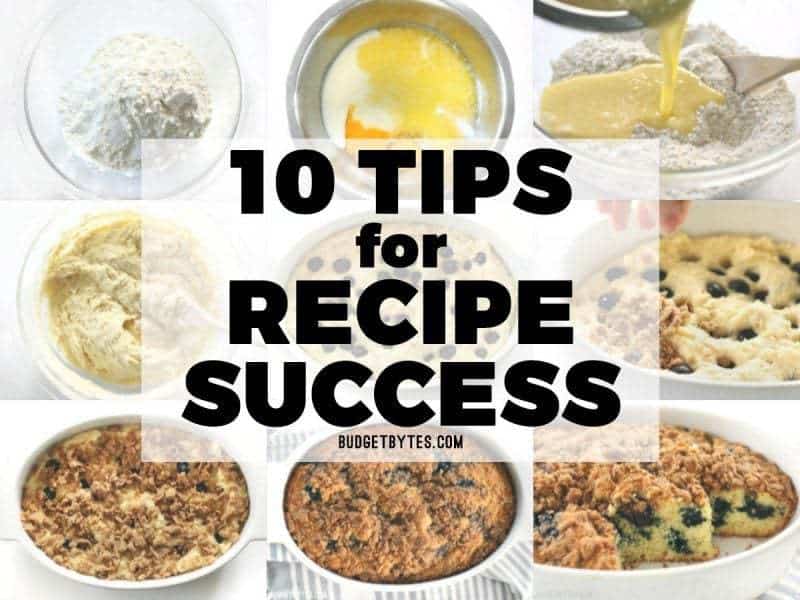
1. Read the Recipes from Beginning to End Before you Begin
Even if it’s a recipe you’ve cooked 10 times before, read through the entire recipe before beginning. This is probably the most overlooked step and one that even I admit to forgetting from time to time (and it ALWAYS ends up in an “oh crap!” moment). Giving a recipe a quick read-through helps prevent surprises, forgotten ingredients, and can help you form a mental game plan of how you’ll execute the recipe. On my site, I also suggest browsing through the step by step photos before beginning to cook, for an extra bit of disaster insurance.
2. Google Unfamiliar Words
We’re so lucky to have the internet and all of its information at our fingertips! If you come across a word in a recipe that you’re unfamiliar with, take a second to look it up. If it’s a cooking technique, chances are you’ll probably even be able to find a short tutorial video showing you exactly how it’s done and that’s like having a free, on the spot cooking class!
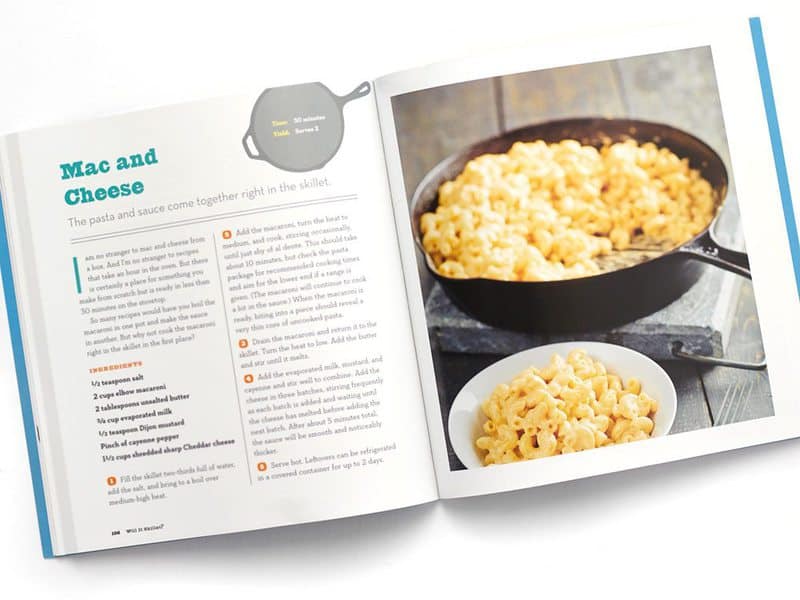
3. Pay Attention to How Ingredients are Listed
One thing that often trips people up is the term “divided,” as in “1/2 cup chopped nuts, divided.” When you see “divided” listed after an ingredient, this means the amount listed is the total amount used in the recipe, but you’ll use a portion of that amount in one step, and the rest later on. You can find out how much to use and when by reading the instructions (see tip #1!). For instance, with the chopped nuts example, the recipe may require you to stir 1/4 cup of the chopped nuts into a muffin batter and use the remaining 1/4 cup to sprinkle on top later. Another important designation is the placement of words like “chopped” or “diced.” If an ingredient is listed as “1 cup chopped walnuts” that means you measure one cup of nuts that are already chopped. If it is listed as “1 cup walnuts, chopped” this means that you measure 1 cup of whole walnuts, then chop them after measuring.
4. Read Reviews First
Almost every recipe website and blog has reviews, which can be extremely helpful. Always take reviews with a grain of salt, but look for trends like “this turned out too dry” or “I had to bake for an extra 15 minutes” so you can know which parts of the recipe to approach with caution, or decide if a recipe is too risky all together. I especially encourage this with blog recipes, which may not get the same rigorous testing as recipes from major food magazines or cookbooks. You don’t need to read them all, but at least browse through a few to get a feel for how the recipe performs “in the real world.”
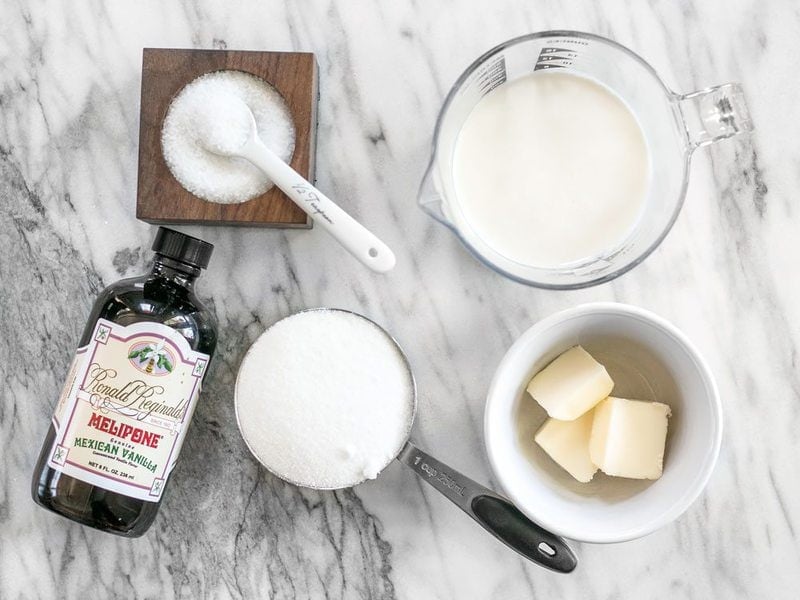
5. Prep Before you Cook
When you’re first learning to cook, it can be helpful to use a technique called “mise en place.” This French phrase simply means to gather all your ingredients and have them prepared (measured, peeled, diced, chopped, etc.) before you begin cooking. This method can take longer than prepping as you cook, but its a great way to make sure no details are missed and it can greatly reduce the stress of multi-tasking. With all your ingredients prepared ahead of time, all of your attention can stay on the hot food in the skillet/pot/oven as you cook so you can avoid burning, boiling over, or any other hiccup.
6. Start Small
If you’re new to cooking, try something simple first and work your way up. Don’t shoot for the stars on your first go. As I mentioned before, the process of cooking is full of all sorts of nuances and requires a great deal of intuition that you have to learn and build over time. If all you know how to do is boil water, start with a simple pasta dish. Try not to choose a recipe that has multiple techniques and ingredients that you’ve never used before. Try one new technique or ingredient at a time.
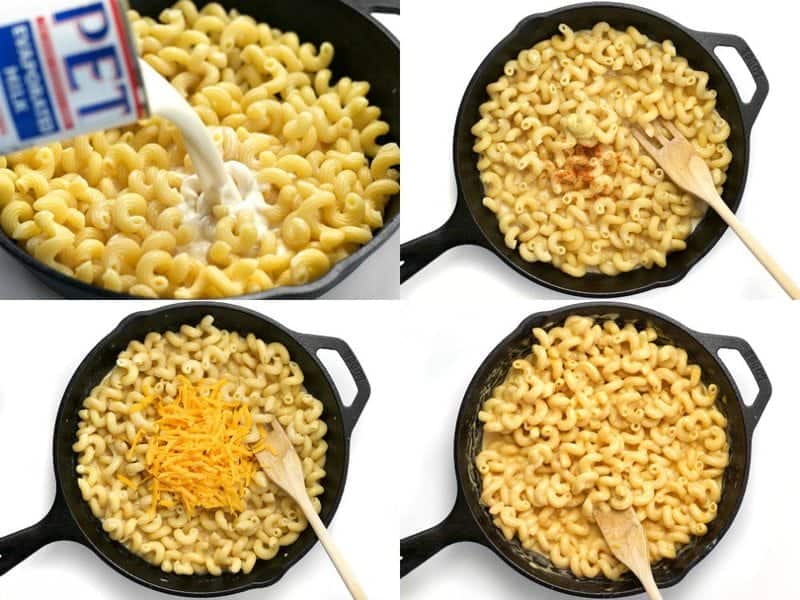
7. Test Recipes Before Special Occasions
There are an infinite number of variables involved with cooking and you want to avoid surprises, so it’s always good to give recipes a test run before big occasions or cooking for guests. It’s not unusual for a recipe to need slight tweaking for your unique mix of equipment and ingredients. Plus, you may just find that you don’t like a recipe as much as you expected from it’s description! :)
8. Use All Your Senses
Most recipes suggest cooking times and temperatures for each step, but it’s always wise to use your senses to tell you whether you need to increase heat, decrease heat, or move on to the next step. If a recipe says to sauté for five minutes, but you see and smell it beginning to burn sooner, STOP. Remove it from the heat and reassess the situation. I try to include sensory cues in my instructions when possible, to help you build your cooking intuition. A good example of sensory cues is when you toast rice in a skillet with a little bit of oil or butter, you’ll begin to smell a nutty aroma, the individual grains will begin to look translucent, and you’ll even hear a popping or crackling noise. I could simply tell you to toast the rice in a skillet with oil for 5 minutes, but if your range top runs hotter than mine or your cookware is thinner, this can change the timing. I can tell you to boil potatoes for ten minutes, but the only way to truly know they’re done is to test the texture by piercing them with a fork. Using your senses helps you really understand what is happening as you cook, and will build your intuition.
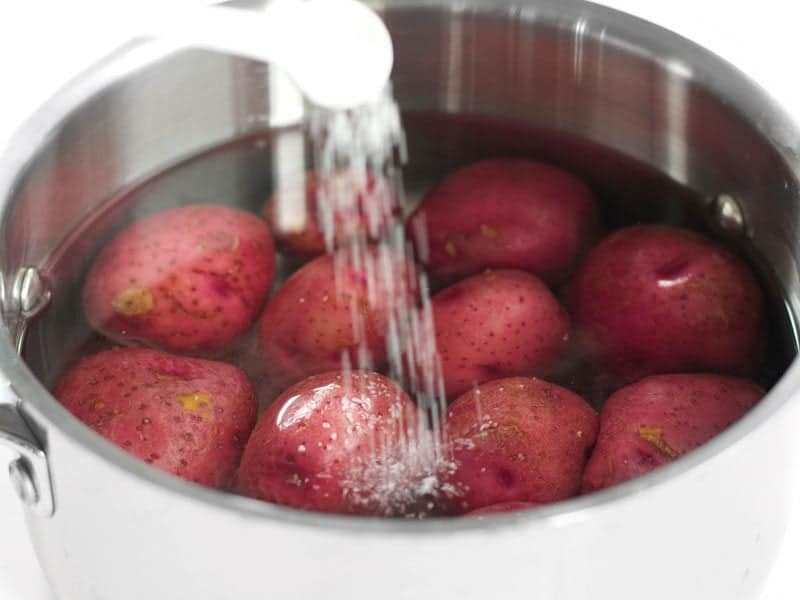
9. Taste As You Go
Speaking of using your senses, it’s very important to taste as you go. The one thing that varies the most in the cooking process is the taste buds of the individual, sensitivity to salt in particular. Try to taste the food as you go (avoiding raw meat and eggs) to make sure the food is seasoned to your palate. Tasting as you go will also help you learn how the flavor of herbs and spices change throughout the cooking process, allowing you to understand how and when to add them to customize recipes in the future.
10. Experiment With Caution
Every time you swap out an ingredient, no matter how small, it will change the flavor, texture, or both of the final recipe. Make sure you’re familiar with a recipe or cooking technique before you attempt to substitute ingredients. Read through those reviews to see if anyone else has already attempted the same substitution. Be aware that changing ingredients may also change the time or temperature needed to cook the dish. Making a recipe your own is a wonderful thing and I fully support customizing recipes to fit your needs, but make sure you do it with caution and with the knowledge that the outcome will be different from the original.
What are your favorite cautionary tips that you’d share with a new cook? Or something you’d tell yourself if you could go back in time to your first recipe? Share your wisdom in the comments below!


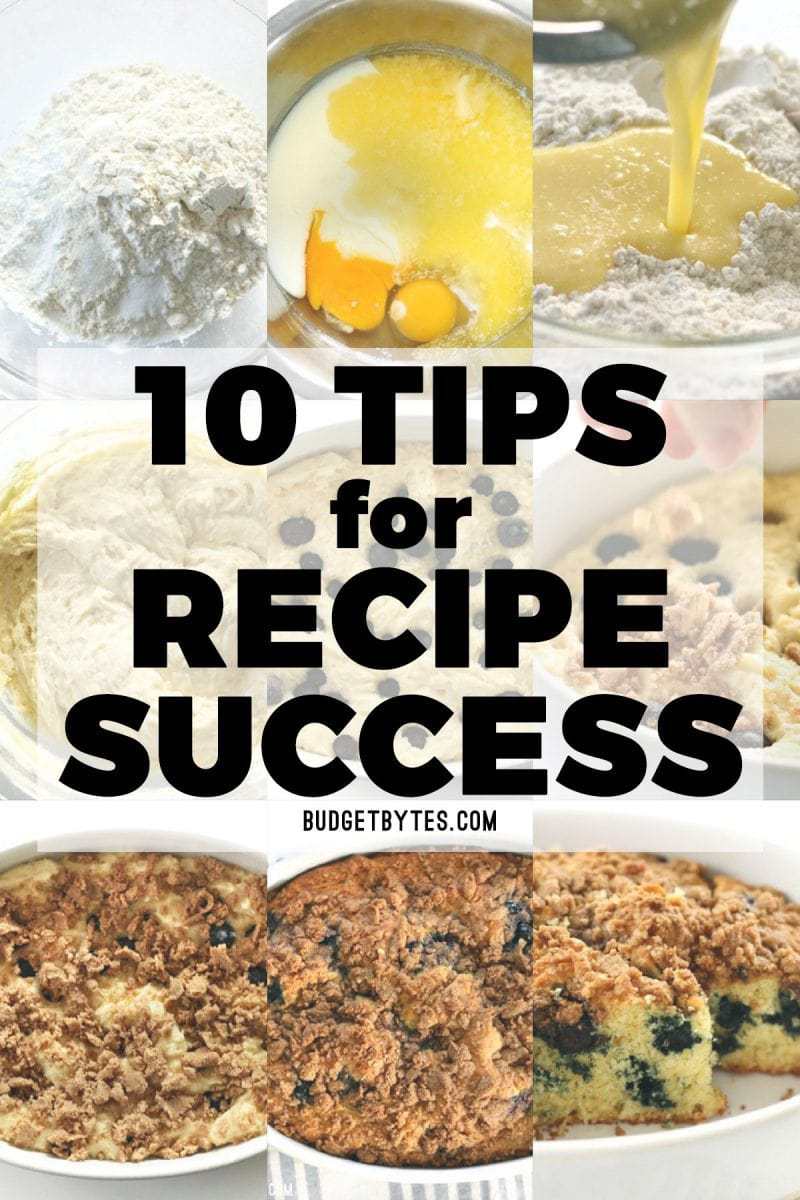
#5 was the biggest help for me when I first started.
Love these tips. I made pfefferneuse for my son-in-law at Christmas. Made them for over 20 years so didn’t worry. I realized too late I’d forgotten to add the baking soda. Oops. The cookies were more dense and not salty enough. They were edible but he didn’t like them; the one cookie he’ll eat and I messed them up due to not going through the recipe “one more time” before starting.
Another tip for older cooks: Go find your reading glasses and use them! Don’t guess you are reading correctly just because you’ve made the recipe so many times!
These are so helpful! I totally agree with the “experiment with caution” part. For me it’s always best to follow the recipe closely the first time I make it so I know what I’m working with. But after that, one of my favorite parts of home cooking is being able to (over time) customize a recipe to exactly fit my tastes. Eventually you end up with a set of things you can make that are *exactly* as spicy as you want, *exactly* as cheesy, etc. Being able to experiment the right way comes with time and skill but it’s one of the big advantages of being a home cook :)
Great tips! I especially like “Experiment with Caution” because I normally don’t have all of the ingredients for recipes that I find so I sometimes substitute with what I have on hand. And it can be tricky! Thanks!
A nice Cliff Notes version of cooking wisdom.
Over the years I have learned that it is very important for me to make notes either directly on the recipe that I printed out or in the book or perhaps even in a separate notebook that I keep for such things. We learn from our own adjustments and or mistakes and writing them down make sure that we will do better next time
This is also my #1 tip when following a recipe. I leave notes that say, “next time add….” or “try reducing _____ by 1 tablespoon”, etc. If I have changed up the recipe, I write down the new contents, measurements, cook time etc.
Mise en place is also a great way to break up a recipe into smaller chunks of time. For instance, if I have extra time in the morning, I’ll chop veggies for dinner and put them back in the fridge, ready for when I get home from work. Chopping, measuring, mixing dry ingredients, or mixing sauces can all be done ahead of time with a lot of recipes. Coming home to make a recipe with mise en place already set up is like having your own sous chef! Doing recipes one part at a time can also make them less intimidating and be helpful for those who have trouble standing for long periods of time.
I love that!
Great tips! I’ve always wondered why some recipes were listed as “walnuts, chopped” vs “chopped walnuts” but figured it was just a style preference!
Me too!
Really useful tips.Especially mac and cheese, next time will be adding new ingredient or new technique in my recipe.
“Another important designation is the placement of words like “chopped” or “diced.” If an ingredient is listed as “1 cup chopped walnuts” that means you measure one cup of nuts that are already chopped. If it is listed as “1 cup walnuts, chopped” this means that you measure 1 cup of whole walnuts, then chop them after measuring.”
I never knew of this distinction! Thanks!
Awesome tips! I just want to let you know that your food recipes are very reliable compared to many that are listed online. You’re thorough in your directions and actually explain why you do certain things a certain way so it’s really easy to learn cooking tips and tricks from your recipes as well. Thank you for all your work and I can’t wait to try more of your recipes this year! xx
Thank you!
These are all great tips – I wish I’d had them, and this website, when I had started cooking a few years ago!
(small grammar note: rather than sensory queues, I think the term would be sensory ~cues~? though I do like the image of smells and sights lining up all nice and orderly!)
LOL, you’re right! Thanks for catching that! :D
Great tips. Thanks for sharing.
Something else worth noting is that not all substitutions are created equal. Some things you can substitute in recipes without any major difference in quality (i.e. a neutral flavored oil in lieu of melted butter), some things can be substituted with noticeable but relatively minor differences in the results/flavors (i.e. water in lieu of stock, dried spices instead of fresh, etc), and some substitutions will result in an end product that is wholly different (and probably completely inferior) than the original (i.e. substituting skim milk for heavy cream). Do research!!!!! Many recipes can easily be adapted to fit the limitations of your pantry, diet, or budget, but be smart about it and have a game plan for how you’re going to make the recipe work. I’m not a content creator, but as an avid home cook, it can be mindboggling to see the sort of substitutions/alterations that amateur cooks make to recipes, and then complain about their finished product not being comparable to the recipe. (I literally once saw a comment on a food blog’s recipe complaining about the finished product, when instead of baking it in the oven @350 for 30 minutes, the commentor had microwaved it for 30 minutes instead. My jaw dropped.)
WOW. hahah
Great advice! I shared it with my boyfriend who is still learning to cook. I think you meant “cue” instead of “queue” though.
Doh! Thank you for catching that!